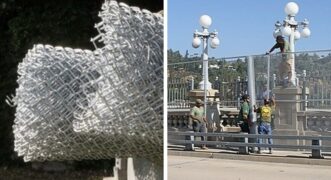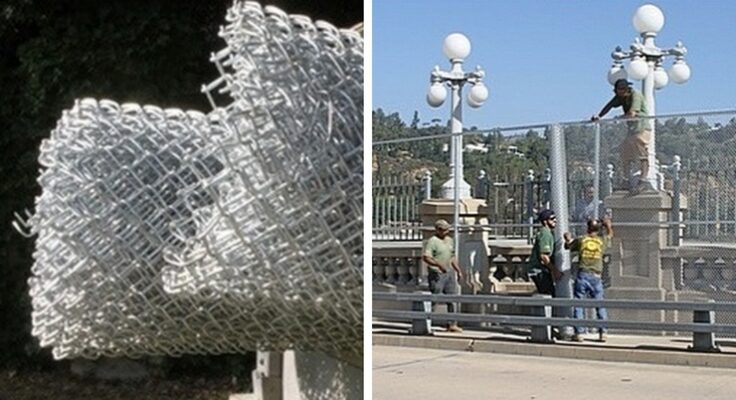
Ahead of the July 19 Colorado Street Bridge Party, the San Rafael Neighborhoods Association is calling on the City of Pasadena to make a long-awaited decision on permanent suicide prevention barriers for the iconic bridge.
The call came in a statement released Wednesday, in which the group questioned the appropriateness of celebrating the historic structure while a temporary chain-link fence—originally installed in 2017 as a short-term safety measure—continues to line the landmark.
“This prolonged indecision has not only delayed the necessary infrastructure improvement, but it has also cost the city time and taxpayer money—without producing results,” the association said in the statement. “While design sensitivity matters, the endless pursuit of a ‘perfect’ aesthetic is no longer productive or fiscally responsible.”
Pasadena Heritage is set to host its biennial Colorado Street Bridge Party on Saturday. The event celebrates the 1913 Beaux-Arts architectural bridge, known for its graceful arches and sweeping views over the Arroyo Seco.
But for nearly a decade, city officials, design consultants and stakeholders have debated how to install permanent suicide deterrents without compromising the bridge’s historic character.
A City engineer told Pasadena Now the City recognizes the lengthy and, at times, challenging process.
“We understand the community’s frustration, and we want to assure everyone that City staff has been working diligently toward a thoughtful and lasting solution,” said Brent Maue.
“Balancing public safety, historic preservation, community input, and long-term stewardship is a complex task, and we appreciate the community’s patience and continued engagement.”
According to Maue, full-scale mock-ups are under construction for internal validation, allowing first responders and staff to evaluate climb resistance, emergency access, durability, maintenance, and aesthetics.
Once this evaluation is complete, recommendations will be presented to the Design Commission, the Public Safety Committee, and ultimately the City Council, with these presentations anticipated to begin later this summer and continue into the fall.
“Depending on the outcomes of these reviews, full-scale mock-ups may then be installed on the bridge itself for public viewing and feedback,” Maue said. “We remain fully committed to advancing a solution that protects lives, preserves the beauty of this historic landmark, and reflects Pasadena’s values.”
The bridge has a long, tragic history. However, the precise number of people who have leapt to their deaths from the bridge or when these incidents began is uncertain due to incomplete or inconsistent records.
According to some reports, after the bridge appeared in a Charlie Chaplin film, people began traveling to the site during the Great Depression to commit suicide.
Some reports claim more than 150 people have jumped from the bridge, with over half of the deaths occurring during the 1930s.
On May 1, 1937, Myrtle Ward, a 22-year-old mother who had lost her job during the Depression, wrapped her 3-year-old daughter, Jean Pykkonen, in a thick wool coat and threw her off the bridge before jumping herself. Ward died, but the child survived after the coat snagged on tree branches and slowed her fall.
In the modern era, more than 30 suicides have occurred since 2006, with authorities successfully talking down dozens of others. In 2017 alone, 10 people jumped to their deaths, while 22 others were either talked down or seen contemplating suicide near the bridge.
That year, then-City Manager Steve Mermell declared a local emergency after police spent 13 hours talking down a man over Labor Day weekend. Using emergency powers, Mermell authorized $295,932 to install fencing along both sides of the 1,400-foot bridge.
The city had previously installed mesh and barbed wire barriers and added suicide prevention signs in the early 1990s. Concerns intensified following the approval of a Habitat for Humanity housing project directly beneath the span.
Some residents have advocated for removing the fencing entirely and restoring the bridge’s original appearance, but officials have cited the effectiveness of the temporary barrier and the city’s obligation to maintain or improve public safety, according to the statement.
The neighborhood association’s statement also addressed alternative designs such as safety netting, citing concerns about obscuring the bridge’s signature arches, difficulty in performing rescues, and limited effectiveness. The city is currently constructing prototypes of vertical picket and web mesh designs, which are expected to be completed later this summer.
“It’s time for Pasadena to make a decision,” the statement concluded. “The longer the City waits, the more resources it wastes. By not making a decision, the City is actually making a decision to have its landmark remain, in the association’s view, an eyesore.”
The group urged city leaders to act not only for public safety but also out of respect for one of Pasadena’s most iconic civic landmarks.














 2 comments
2 comments


